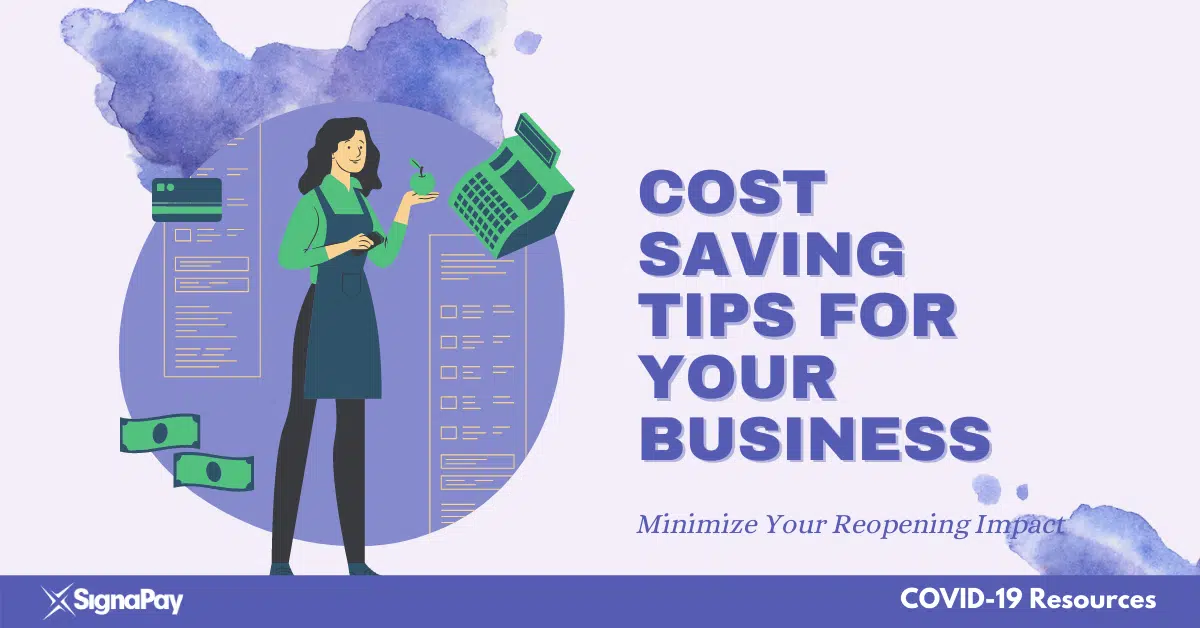Cost-Saving Tips for Your Business

Brick-and-mortar businesses across America are re-opening their doors. However, many are a little anxious about how much their new operating costs will eat into their profits. While many businesses would love to see the same number of visitors they saw in February of 2020, the harsh reality is that until the majority of Americans are vaccinated, visitation won’t be at 100% until late 2021. That leaves many small businesses in a pinch; how can they maintain their business until people are comfortable returning?
Safety First
The most important factor, of course, is maintaining safety guidelines set by the CDC local governing bodies. Besides preventing the spread of infection, it gives consumers the confidence they need to return to your place of business. The same goes for your staff. Be sure to allow them time off to get vaccinated and keep them home if they feel unwell. It will keep COVID incidences down and give your other staff the assurance they need that you are maintaining a healthy working environment.
Check Your Coffers
Assessing financial stability and cash flow should the first things to assess for reopening. Operating a business is expensive and there are many things you can do to limit your financial burden.
- Apply for SBA Loans: The Small Business Administration has many options for loans for small businesses to apply for to help get their business off the ground. The SBA offers a variety of loan types for small businesses of all types and sizes. Visit SBA.gov to learn more.
- Evaluate Your Operating Costs: Things like rent, utilities and even payroll are hard costs associated with operating your business. If possible, renegotiate rent or move to a venue with less rent. Shop around for different utility companies who might be offering introductory rates that could reduce the cost of internet and electricity.
- A thing about payroll costs: Times are tough for employers who want to bring back their staff 100% but are faced with less foot traffic and business. Unfortunately, a way to help keep your costs down is to function with fewer employees than you have available. With foot traffic still down from where it was in 2019, schedule staff to meet those demands. More staff during peak hours, and far less during down time.
We’re Open! Now What?
After evaluating where you can reduce hard costs, now comes the fun part: reopening! But that doesn’t mean things are out of the woods yet. Daily evaluations and maintaining a positive vibe are going to be an endurance race. It’s not about who is the fastest but who can go the furthest.
Consider this: the hardest part of reopening is keeping up morale. Culture is more important than you think and creating an environment where your staff are excited to return to work is going to be vital. It creates less turnover which means less time and payroll hours training new employees. Employees and staff who respond to a positive work culture also provide the best output, working not only hard but more efficiently. This translates directly to dollars in everyone’s pockets.
Be it a restaurant or retail store or services-based businesses, evaluating where your strengths and weaknesses are looks the same. For restaurants, maybe the salmon crudité doesn’t sell nearly as well as the chicken and waffles. That’s okay! Save on cost and remove it from the menu. Analyzing your strongest and weakest performing products allows you to focus on your money-makers and spend less on products that just don’t sell as well.
Analyzation doesn’t stop at just the menu, though. Take a minute to assess other things you may not normally notice. How many lights to you actually need and do they need to stay on as long as they do? Do the computers need to be shut down at night to draw less power? These are things that could really make a difference in what your bill comes out to at the end of the month.
Consider you payment acceptance offerings. Where easily hundreds or even thousands of dollars are spent every month to process payments could be saved with a program such as PayLo. Technologies like PayLo allow a merchant to save on those payment processing costs by sharing it with their consumers on a small scale. A small 3.95% customer assistance fee on every purchase adds up to huge savings on your bottom line. You can learn more at www.getpaylo.com.
The world is opening up again, be ready, be positive, and be ready to make some money!
Recent blog posts
The latest industry news, interviews, technologies, and resources
Strategies for Improving Cost Control and Expense Control
Boosting Your Bottom Line: Strategies for Improving Cost and Expense Control In the fast-paced world of business, keeping a tight grip on costs and expenses is essential for maintaining profitability …
No-Fee Payment Processing: What Businesses Need to Know
No Fee Payment Processing: Understanding Surcharging, Cash Discounts, and Dual Pricing Credit card transactions offer convenient payment options for consumers but often come with fees that can burden businesses. Fortunately, …
Understanding PCI Compliance: Safeguarding Your Business
Discover the essential role of PCI compliance in safeguarding sensitive payment information in today’s digital landscape. Learn about the Payment Card Industry Data Security Standard (PCI DSS) and its stringent requirements for protecting cardholder data across online, in-store, and mobile payment channels. Explore the impact of PCI compliance on data security, operational efficiency, and customer trust. Discover how adherence to PCI standards can mitigate financial risks such as regulatory fines and reputational damage, while enhancing long-term business sustainability. Explore more about PCI compliance and secure your business’s future today.